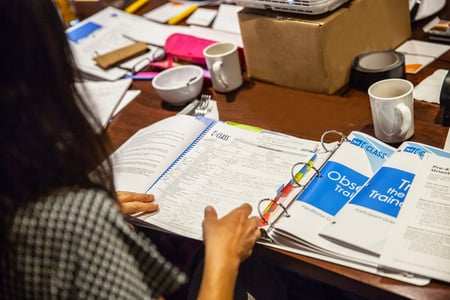
We're happy to share our second post in our series, Notetaking for Trainers. During this series, we'll discuss strategies to help you ensure that your trainees are equipped with the notetaking skills they need to score classrooms reliably. This series is intended for trainers across all age levels. Enjoy!
In our last post, we talked about initial steps that trainers can take to scaffold their trainees’ notetaking skills and increase the objectivity of their notes. In this post, we are going to delve in a little deeper and focus on helping trainees take specific, evidence-based observational notes that align with the CLASS.
As a trainer, you have probably worked with trainees who write down everything they see, regardless of whether or not it illustrates a CLASS-based interaction. While this is preferable to not writing anything at all, we need to help them focus their lenses so they only write down those things that relate to the CLASS. Not only will that help them when they assign codes, but- as we all know- there is not a lot of space on the score sheet to take notes on things that don’t matter.
One way to support targeted notetaking is to review trainees’ notes with them. Try walking around the room as everyone finishes coding and look over the notes of people who are done. Pointing out phrases and quotes that are good exemplars reinforces trainees’ knowledge and boosts their confidence as they see that their notetaking is on track. It’s also very likely that other observations relate to the CLASS, but belong under a different dimension. Encourage them to use their manuals to identify the correct dimension as a way to shore up their knowledge of the tool. When you see notes about things that are not a part of the CLASS (e.g., the trainee notes under Instructional Learning Formats that “the room is very crowded”), ask the trainee to turn to the dimension face page to see where the observation would fit. It’s far more effective for the trainee to recognize that their observation is misplaced than it is for us to simply tell them. Having them look at the face page also emphasizes the use of the manual.
The video discussion is another good time to help trainees refine their skills. As trainees share observations, increase their understanding by repeating, reinforcing, and extending their comments. For example, during a discussion about Teacher Sensitivity, a trainee may note that the teacher asked an upset child if the child felt OK. Reinforce the accuracy of this comment by stating, “Yes, she did ask that question. That’s a great example of awareness.” In doing so, you’re validating their observation and taking their knowledge to the next level by assigning it to an indicator.
What does reinforcing specific notetaking have to do with taking evidence-based notes? Everything. When we help trainees understand which observations are linked to the CLASS and where they fit within the tool, we are teaching them to be evidence-based!

